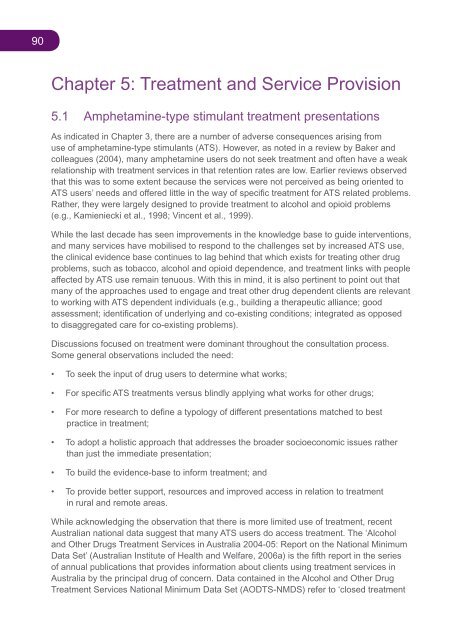National Amphetamine-Type Stimulant Strategy Background Paper
National Amphetamine-Type Stimulant Strategy Background Paper
National Amphetamine-Type Stimulant Strategy Background Paper
You also want an ePaper? Increase the reach of your titles
YUMPU automatically turns print PDFs into web optimized ePapers that Google loves.
90<br />
Chapter 5: Treatment and Service Provision<br />
5.1 <strong>Amphetamine</strong>-type stimulant treatment presentations<br />
As indicated in Chapter 3, there are a number of adverse consequences arising from<br />
use of amphetamine-type stimulants (ATS). However, as noted in a review by Baker and<br />
colleagues (2004), many amphetamine users do not seek treatment and often have a weak<br />
relationship with treatment services in that retention rates are low. Earlier reviews observed<br />
that this was to some extent because the services were not perceived as being oriented to<br />
ATS users’ needs and offered little in the way of specific treatment for ATS related problems.<br />
Rather, they were largely designed to provide treatment to alcohol and opioid problems<br />
(e.g., Kamieniecki et al., 1998; Vincent et al., 1999).<br />
While the last decade has seen improvements in the knowledge base to guide interventions,<br />
and many services have mobilised to respond to the challenges set by increased ATS use,<br />
the clinical evidence base continues to lag behind that which exists for treating other drug<br />
problems, such as tobacco, alcohol and opioid dependence, and treatment links with people<br />
affected by ATS use remain tenuous. With this in mind, it is also pertinent to point out that<br />
many of the approaches used to engage and treat other drug dependent clients are relevant<br />
to working with ATS dependent individuals (e.g., building a therapeutic alliance; good<br />
assessment; identification of underlying and co-existing conditions; integrated as opposed<br />
to disaggregated care for co-existing problems).<br />
Discussions focused on treatment were dominant throughout the consultation process.<br />
Some general observations included the need:<br />
• To seek the input of drug users to determine what works;<br />
• For specific ATS treatments versus blindly applying what works for other drugs;<br />
• For more research to define a typology of different presentations matched to best<br />
practice in treatment;<br />
• To adopt a holistic approach that addresses the broader socioeconomic issues rather<br />
than just the immediate presentation;<br />
• To build the evidence-base to inform treatment; and<br />
• To provide better support, resources and improved access in relation to treatment<br />
in rural and remote areas.<br />
While acknowledging the observation that there is more limited use of treatment, recent<br />
Australian national data suggest that many ATS users do access treatment. The ‘Alcohol<br />
and Other Drugs Treatment Services in Australia 2004-05: Report on the <strong>National</strong> Minimum<br />
Data Set’ (Australian Institute of Health and Welfare, 2006a) is the fifth report in the series<br />
of annual publications that provides information about clients using treatment services in<br />
Australia by the principal drug of concern. Data contained in the Alcohol and Other Drug<br />
Treatment Services <strong>National</strong> Minimum Data Set (AODTS-NMDS) refer to ‘closed treatment

















